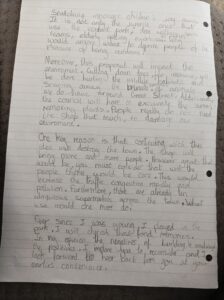
11 Plus Persuasive Letter Planning
Why It Matters
The 11 Plus Creative Writing Exam is a significant milestone for children aspiring to gain admission to selective independent and grammar schools. One of the questions that could pop up in the exam is the ability to write persuasively. Let’s unpick how perfect your child’s 11 Plus persuasive letter planning so they showcases their command over language but also demonstrates their ability to influence and convince.
In this guide, we will explore the essential elements of writing a persuasive letter for the 11 Plus Creative Writing Exam, equipping your child with the skills to excel in this area.
Grab a list of perfect phrases for your persuasive letter: Key Persuasive Writing Phrases
"If you want to be a writer, you must do two things above all others: read a lot and write a lot."
Stephen King
Understanding the Audience:
Before diving into the writing process, it’s important to understand the audience. Consider who is the letter aimed at and their perspective and expectations. The purpose of a persuasive letter is to influence the reader, so tailoring your content to the reader’s preferences is key.
Structural Components:
A persuasive letter, like any piece of writing, requires a clear structure to effectively convey your message.
Plan your letter into three main parts:
- The introduction
- The body (roughly two paragraphs)
- The conclusion
Grab hold of your own Letter Planning Template: Persuasive Letter Planner Template
Introduction:
Grab the examiner’s attention from the outset. Begin with a powerful opening statement or how about a thought-provoking question? Introduce the purpose of your letter, clearly stating your position or viewpoint. Engage the reader by establishing a connection or relevance to their values.
Example: ‘Dear Headteacher,
Imagine a school where creativity knows no bounds? Where every child is encouraged to explore their potential beyond their imagination. Today, I wish to tell you why I believe we should have more creative writing teaching as part of our curriculum.’ Get the drift?
"With writing, we have second chances."
Jonathan Safran Foer
Body:
The body of your persuasive letter is where you present your arguments in a logical and organised manner.
Each paragraph should focus on a single point, supported by evidence and even personal examples. Be concise and articulate, ensuring that your ideas flow seamlessly from one to the next. You can do this – just give it a go!
State Your Position Clearly:
Clearly describe your viewpoint. Whether you’re advocating for a particular change, expressing your opinion, or proposing an idea, make it clear to the reader.
Example: “In light of the proven benefits of creative writing in fostering critical thinking and confidence, I strongly believe that our school should place a greater emphasis on including creative writing programs into the curriculum.”
Provide Supporting Evidence:
Back up your arguments with solid evidence. This could be statistics, real-life examples, or expert opinions. Demonstrating that your position is well-founded adds punch to your letter.
Example: ‘Studies have consistently shown that children who engage in regular creative writing activities demonstrate improved problem-solving abilities, enhanced linguistic skills, and increased confidence in expressing their thoughts.’
Address The Other Point of View:
Anticipate potential counterarguments and address them thoughtfully. Acknowledging opposing viewpoints demonstrates a well-rounded understanding of the issue, adding amazing power to your letter.
Example: ‘While some argue that traditional subjects hold greater importance, it’s essential to recognise that creativity is the driving force behind innovation in an ever-evolving world.’
"If I waited for perfection, I would never write a word."
Margaret Atwood
Conclusion: 11 Plus Persuasive Letter Planning
Summarise your key points and restate your main argument in a powerful and memorable way. End with a clear description about what you want the person to do or a compelling thought that lingers in the reader’s mind.
Example: ‘In conclusion, embracing creative writing in our school curriculum is not just an investment in education; it’s an investment in the future of our students. Let’s arrange a meeting over a cup of tea at your earliest convenience.
5 TOP TIPS:
Language and Style
The language and style of your persuasive letter play a crucial role in conveying your message effectively. Here are some tips to enhance your writing:
Use Persuasive Language
Choose words that evoke emotion and conviction. Be passionate in your expression, and carefully select adjectives that emphasise the importance of your message.
Example: Instead of saying, ‘Creative writing is beneficial’, opt for ‘Creative writing is undeniably crucial in the development of a well-rounded individual.’
Vary Sentence Structure
Maintain a dynamic flow by varying your sentence structure. Combine short and long sentences to create rhythm and maintain the reader’s interest.
Example: ‘Not only does creative writing foster imagination, but it also cultivates the ability to think critically about the world around us, preparing students for the challenges they will face in the workplace.’
Be Concise
Avoid unnecessary details in your sentences. Keep your writing concise and focused, ensuring every sentence serves a purpose.
Example: ‘In a time dominated by rapid technological advancements, nurturing creativity is not a luxury but a necessity. Our students deserve an education that equips them with the skills to navigate the complexities of the modern world.’
Editing and Revision
The final step in crafting a persuasive letter for the 11 Plus Creative Writing Exam is thorough editing and revision. Pay attention to grammar, punctuation, and overall coherence. Consider seeking feedback from teachers or family members to gain different perspectives on the effectiveness of your letter.
A Round-up:
Mastering the art of persuasion is a valuable skill that extends beyond the 11 Plus Creative Writing Exam. By understanding your audience, structuring your letter effectively and refining your personal writing style, you can create a letter that packs a punch.
Remember, the power to influence lies in your words – use them wisely and watch your ideas come to life on paper.
After nearly a decade teaching in leading schools in South west London, Clare became a full-time online private English tutor helping children to excel at English.
Check out an excellent example of sentence openers in a persuasive letter:
Clare is an experienced teacher and a leading UK private English tutor. Ready to unlock the skills and bold confidence in your child?
Website: www.creativehare.co.uk | Email: clare@creativehare.co.uk

Related articles

11+ English Sample Papers
Here's a list of 11+ English papers, FREE for you to download.
Read more
How Matteo reaped the benefits of 11 Plus tuition
Matteo was in Year 4 and attending a small independent school in North London when we first started working together.
Read moreStay In The Loop
"*" indicates required fields
Your privacy and trust are important to us. We will never sell, abuse, or misuse your personal information.
For full details please see our privacy policy.


